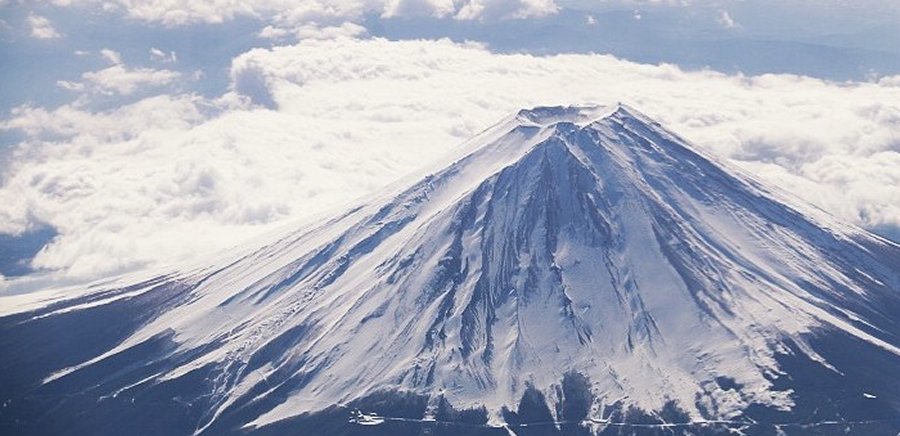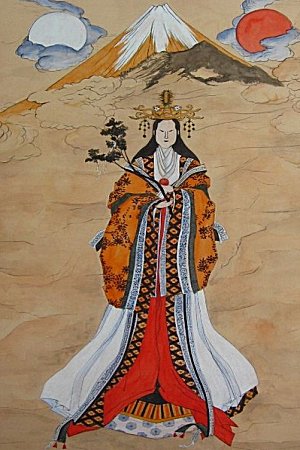MessageToEagle.com – Sacred Mount Fuji on Honshu Island, Japan has been widely venerated mountain in Japan since ancient times. People of both Buddhist and Shinto faiths considered it an Abode of the Immortals.

The Japanese have long regarded certain mountains as objects of worship. They believed that mountains are sacred places where numerous gods reside. This belief still lives on and is continuously practiced in Japan.
Mt Fuji is the highest and also the youngest of the Japanese mountain formations. This symmetrical volcano raises to 3776 m (12,388 feet) and represents the symbol of Japan.
In the earthquake that occurred in 286 AD, there was a strong, fiery eruption and the mighty Mt Fuji (also known as Fujiyama) emerged suddenly during only one night.

This mighty mountain became admired and feared as well.
Mount Fuji, of which its magnificent peak has been spectacularly described as “the Supreme Altar of the Sun”, has been a place of pilgrimage for centuries.
According to the old Shinto tradition, the pilgrims, wearing white clothes and large straw hats, formed processions accompanied by ringing bells and chanting:
“May our six senses be pure, and the weather on the honourable mountain be fair.”
By climbing the mountain from the bottom to the top and then back, the pilgrims traditionally believed they could wash away their sins.
High snow-capped mountains made people aware of the source of abundant pure water.
It was believed that the mountain deities could miraculously call clouds to collect rain when needed.
We learn from great works of prominent British Japanologist, Professor Basil Hall Chamberlain, that “down to times almost historical the country round Fuji formed part of Aino-land, and all Eastern Japan is strewn with names of Aino origin.”
In fact, another name of Mt Fuji is “Fuchi”, which was also the name of the Aino Goddess of Fire, the guardian of home and hearth in beliefs of semi-nomadic Aino people who inhabited the northern islands of Japan.
See also:
First Peoples Of Japan: Ainu Civilization And Its Unknown Origin
Japan’s Sacred Island Of Yakushima: Remarkable Treasures Of Nature Surrounded By Myths And Legends
Jizo – The Protector Of Children, Travelers And Women
Nue – Mysterious Mythological Shape-Shifting Creature Transforming Into A Black Cloud
More Fascinating Myths And Legends From All Across The World
A Buddhist myth tells that Mt. Fuji was a female and another mountain, Mt. Haku (a male) was higher. Angry Fuji beat the god of Mt. Haku on the head, cracking his skull into eight smaller mountain peaks. Her action made her the highest mountain in Japan, forever.
Another Buddhist myth says that Mt. Fuji represented the source of Water of Life, which flowed from a stream on the slopes guarded by Sengen, the daughter of the mountain god.
As a site of spiritual significance, Mt Fuji was divided into three zones. The everyday world was located at the bottom of Mt Fuji in the zone, called Kusa-yama. Another zone, Ki-yama, was the transient realm between the world of humans and the abode of gods. The third zone, Yake-yama, located at the top was the realm of the gods, Buddha and death.
Fuji was once a powerful active volcano. Japan is located in the Pacific “Ring of Fire,” therefore, many of Japan’s mountains are of volcanic origin. There are currently 186 volcanoes, sixty of which are active.
It was natural that people heavily dependent on agriculture, worshiped such mountains.
The worship of them is frequently linked to the worship of countless watersheds and streams. Over the centuries, the people built numerous shrines on the summits of other mountains, not only Mt Fuji and venerated many various mountain deities.
However, the mighty Mt. Fuji, the center of the world, will stand forever above all of them,
Copyright © MessageToEagle.com All rights reserved. This material may not be published, broadcast, rewritten or redistributed in whole or part without the express written permission of MessageToEagle.com
Expand for references
References:
R. Alexander, Myths, Symbols and Legends of Solar System Bodies
F. Hadland Davis, Myths & Legends of Japan






